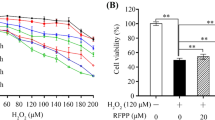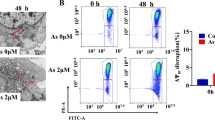Abstract
Arsenite is a cytotoxic reagent that has been used clinically to treat certain cancers. Although the cytotoxic mechanisms of arsenite have been investigated, the cellular mechanisms that act against arsenite damage are poorly understood. Heme oxygenase 1 (HO-1) has been implicated in cellular survival under other multiple stress conditions. Here, we show that a significant induction of HO-1 expression is present in human bronchial epithelial cells (Beas-2B) treated with lethal doses of arsenite treatment. This induction depends on the known ERK/AP1 signaling pathway. As expected, HO-1 RNAi knockdown, or ERK/AP1 inhibition, renders the Beas-2B cells more sensitive to arsenite damage. Our data thus suggest that transcriptional upregulation of HO-1 expression via a putative ERK/AP-1 pathway constitutes an inherent mechanism by which arsenite-induced apoptosis is attenuated.





Similar content being viewed by others
References
Ameyar M, Wisniewska M, Weitzman JB (2003) A role for AP-1 in apoptosis: the case for and against. Biochimie 85:747–752
Bach FH (2002) Heme oxygenase-1 as a protective gene. Wien Klin Wochenschr 114(Suppl 4):1–3
Chen H, Wang L, Gong T, Yu Y, Zhu C, Li F, Li C (2010) EGR-1 regulates Ho-1 expression induced by cigarette smoke. Biochem Biophys Res Commun 396:388–393
Cheng YH, Ou BR, Cheng LC, Lu JH, Yeh JY (2008) Glutathione regulation in arsenic-induced porcine aortic endothelial cells. Toxicol In Vitro 22:1832–1839
Druwe IL, Vaillancourt RR (2010) Influence of arsenate and arsenite on signal transduction pathways: an update. Arch Toxicol 84:585–596
Eguchi R, Fujimori Y, Takeda H, Tabata C, Ohta T, Kuribayashi K, Fukuoka K, Nakano T (2011) Arsenic trioxide induces apoptosis through JNK and ERK in human mesothelioma cells. J Cell Physiol 226:762–768
Fung H, Liu P, Demple B (2007) ATF4-dependent oxidative induction of the DNA repair enzyme Ape1 counteracts arsenite cytotoxicity and suppresses arsenite-mediated mutagenesis. Mol Cell Biol 27:8834–8847
Gabunia K, Ellison SP, Singh H, Datta P, Kelemen SE, Rizzo V, Autieri MV (2012) Interleukin-19 (IL-19) induces heme oxygenase-1 (HO-1) expression and decreases reactive oxygen species in human vascular smooth muscle cells. J Biol Chem 287:2477–2484
Gao M, Dong W, Hu M, Yu M, Guo L, Qian L, Guo N, Song L (2010) GADD45alpha mediates arsenite-induced cell apoptotic effect in human hepatoma cells via JNKs/AP-1-dependent pathway. J Cell Biochem 109:1264–1273
Kligerman AD, Tennant AH (2007) Insights into the carcinogenic mode of action of arsenic. Toxicol Appl Pharmacol 222:281–288
Kumagai Y, Sumi D (2007) Arsenic: signal transduction, transcription factor, and biotransformation involved in cellular response and toxicity. Annu Rev Pharmacol Toxicol 47:243–262
Lopez-Bergami P, Huang C, Goydos JS, Yip D, Bar-Eli M, Herlyn M, Smalley KS, Mahale A, Eroshkin A, Aaronson S, Ronai Z (2007) Rewired ERK-JNK signaling pathways in melanoma. Cancer Cell 11:447–460
Paine A, Eiz-Vesper B, Blasczyk R, Immenschuh S (2010) Signaling to heme oxygenase-1 and its anti-inflammatory therapeutic potential. Biochem Pharmacol 80:1895–1903
Salameh A, Galvagni F, Anselmi F, De Clemente C, Orlandini M, Oliviero S (2010) Growth factor stimulation induces cell survival by c-Jun. ATF2-dependent activation of Bcl-XL. J Biol Chem 285:23096–23104
Taylor BF, McNeely SC, Miller HL, Lehmann GM, McCabe MJ Jr, States JC (2006) p53 suppression of arsenite-induced mitotic catastrophe is mediated by p21CIP1/WAF1. J Pharmacol Exp Ther 318:142–151
Wang Y, Xu Y, Wang H, Xue P, Li X, Li B, Zheng Q, Sun G (2009) Arsenic induces mitochondria-dependent apoptosis by reactive oxygen species generation rather than glutathione depletion in Chang human hepatocytes. Arch Toxicol 83:899–908
Wu ML, Layne MD, Yet SF (2012) Heme oxygenase-1 in environmental toxin-induced lung disease. Toxicol Mech Methods 22:323–329
Acknowledgments
This project is supported by National Natural Science Foundation of China No. 31171342 and 31270797, and the National Key Research and Development Programs on Fundamental Sciences (973 Project) 2011CB503803 to Dr. Lun Song.
Author information
Authors and Affiliations
Corresponding author
Rights and permissions
About this article
Cite this article
Aodengqimuge, Liu, S., Mai, S. et al. AP-1 activation attenuates the arsenite-induced apoptotic response in human bronchial epithelial cells by up-regulating HO-1 expression. Biotechnol Lett 36, 1927–1936 (2014). https://doi.org/10.1007/s10529-014-1560-z
Received:
Accepted:
Published:
Issue Date:
DOI: https://doi.org/10.1007/s10529-014-1560-z




